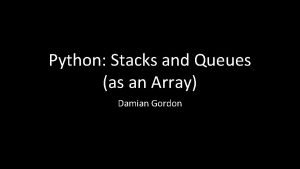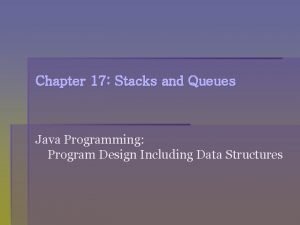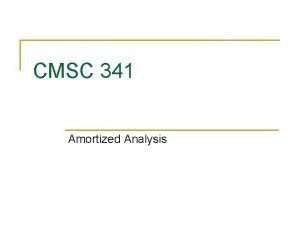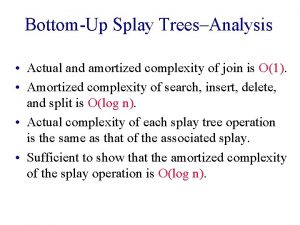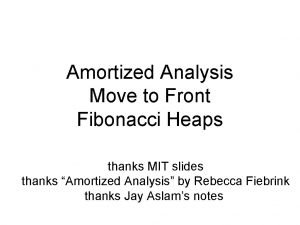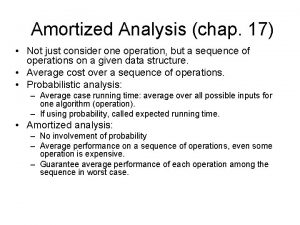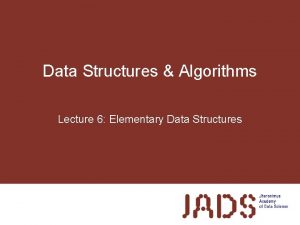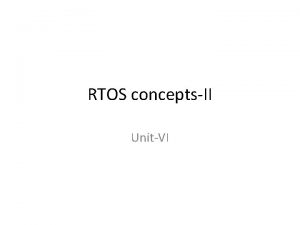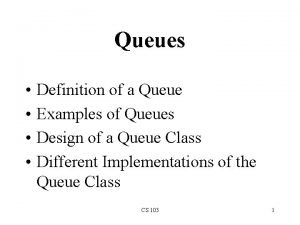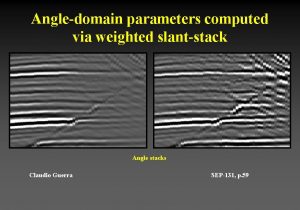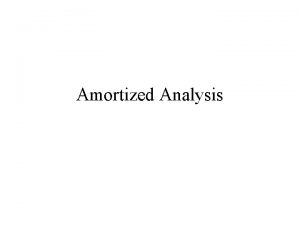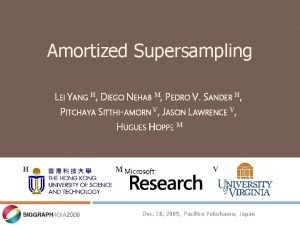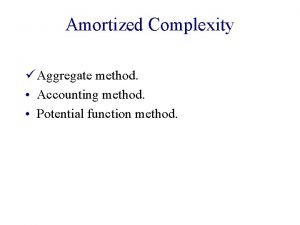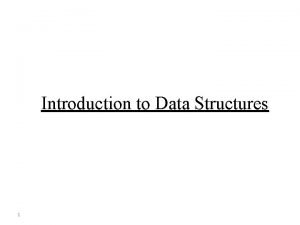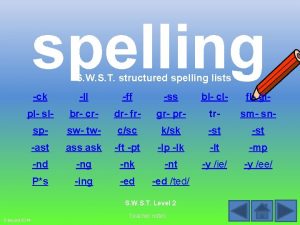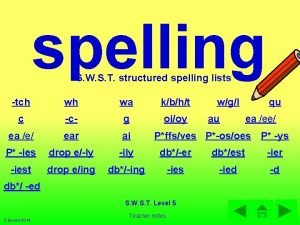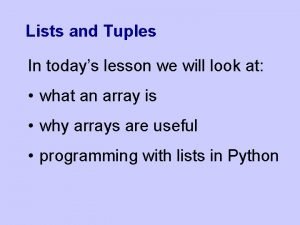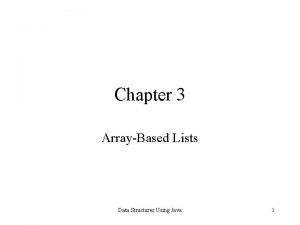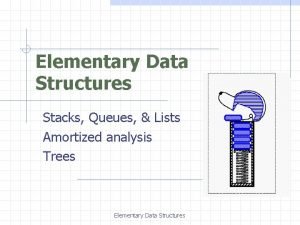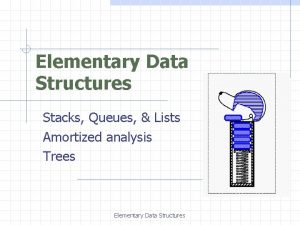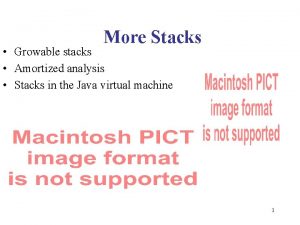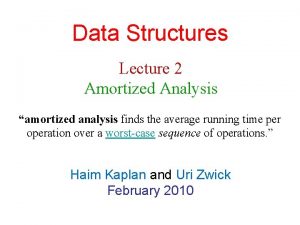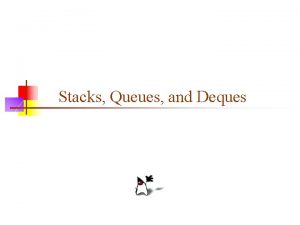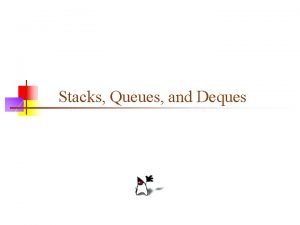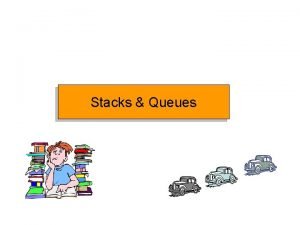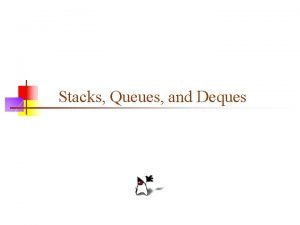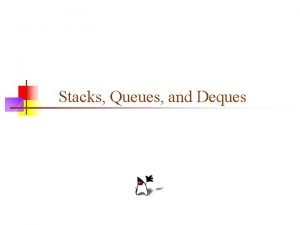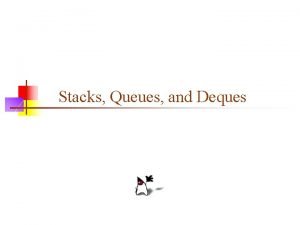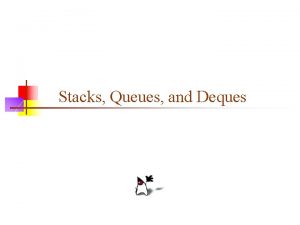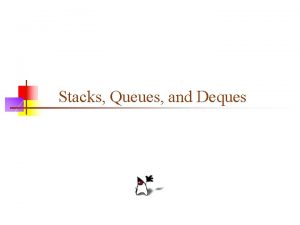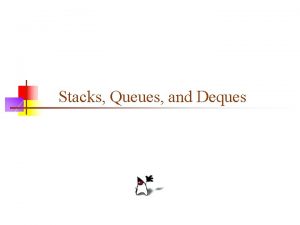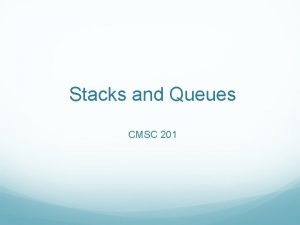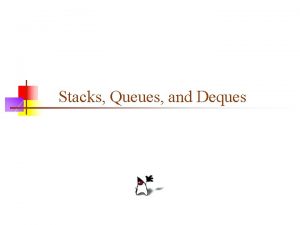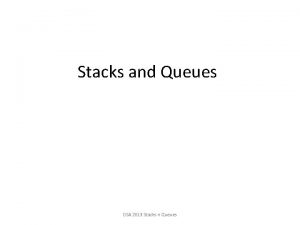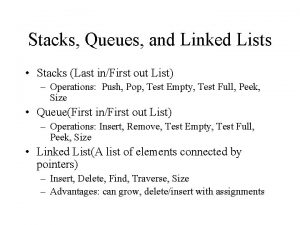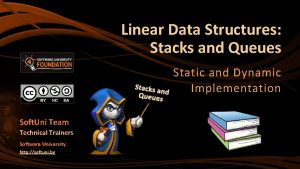Elementary Data Structures Stacks Queues Lists Amortized analysis


















































- Slides: 50

Elementary Data Structures Stacks, Queues, & Lists Amortized analysis Trees Elementary Data Structures

Abstract Data Types (ADTs) An abstract data type (ADT) is an abstraction of a data structure An ADT specifies: n n n Data stored Operations on the data Error conditions associated with operations Example: ADT modeling a simple stock trading system n n The data stored are buy/sell orders The operations supported are w order buy(stock, shares, price) w order sell(stock, shares, price) w void cancel(order) n Error conditions: w Buy/sell a nonexistent stock w Cancel a nonexistent order Elementary Data Structures 2

Stacks Elementary Data Structures

Outline and Reading The Stack ADT (§ 2. 1. 1) Applications of Stacks (§ 2. 1. 1) Array-based implementation (§ 2. 1. 1) Growable array-based stack (§ 1. 5) Elementary Data Structures 4

The Stack ADT stores arbitrary objects Insertions and deletions follow the last-in first-out scheme Think of a spring-loaded plate dispenser Main stack operations: n n push(object): inserts an element object pop(): removes and returns the last inserted element Auxiliary stack operations: n n n Elementary Data Structures object top(): returns the last inserted element without removing it integer size(): returns the number of elements stored boolean is. Empty(): indicates whether no elements are stored 5

Exceptions Attempting the execution of an operation of ADT may sometimes cause an error condition, called an exception Exceptions are said to be “thrown” by an operation that cannot be executed In the Stack ADT, operations pop and top cannot be performed if the stack is empty Attempting the execution of pop or top on an empty stack throws an Empty. Stack. Exception Elementary Data Structures 6

Applications of Stacks Direct applications n n n Page-visited history in a Web browser Undo sequence in a text editor Chain of method calls in the Java Virtual Machine or C++ runtime environment Indirect applications n n Auxiliary data structure for algorithms Component of other data structures Elementary Data Structures 7

Method Stack in the JVM 1 main() { The Java Virtual Machine (JVM) int i = 5; keeps track of the chain of 3 foo(i); active methods with a stack } When a method is called, the foo(int j) { JVM pushes on the stack a int k; frame containing k = j+1; n Local variables and return value bar(k); n Program counter, keeping track of 7 the statement being executed When a method ends, its frame …. } is popped from the stack and control is passed to the method 9 bar(int m) on top of the stack { … Elementary Data Structures } bar PC = 9 m=6 foo PC = 7 j=5 k=6 main PC = 3 i=5 8

Array-based Stack A simple way of implementing the Stack ADT uses an array We add elements from left to right A variable keeps track of the index of the top element (size is t+1) Algorithm size() return t + 1 Algorithm pop() if is. Empty() then throw Empty. Stack. Exception else t t 1 return S[t + 1] … S 0 1 2 t Elementary Data Structures 9

Array-based Stack (cont. ) The array storing the stack elements may become full A push operation will then throw a Full. Stack. Exception n n Algorithm push(o) if t = S. length 1 then throw Full. Stack. Exception else t t+1 Limitation of the array. S[t] o based implementation Not intrinsic to the Stack ADT … S 0 1 2 t Elementary Data Structures 10

Performance and Limitations Performance n n n Let n be the number of elements in the stack The space used is O(n) Each operation runs in time O(1) Limitations n n The maximum size of the stack must be defined a priori and cannot be changed Trying to push a new element into a full stack causes an implementation-specific exception Elementary Data Structures 11

Growable Array-based Stack In a push operation, when the array is full, instead of throwing an exception, we Algorithm push(o) if t = S. length 1 then can replace the array with A new array of a larger one size … How large should the new for i 0 to t do array be? A[i] S[i] n n incremental strategy: increase the size by a constant c doubling strategy: double the size Elementary Data Structures S A t t+1 S[t] o 12

Comparison of the Strategies We compare the incremental strategy and the doubling strategy by analyzing the total time T(n) needed to perform a series of n push operations We assume that we start with an empty stack represented by an array of size 1 We call amortized time of a push operation the average time taken by a push over the series of operations, i. e. , T(n)/n Elementary Data Structures 13

Incremental Strategy Analysis We replace the array k = n/c times The total time T(n) of a series of n push operations is proportional to n + c + 2 c + 3 c + 4 c + … + kc = n + c(1 + 2 + 3 + … + k) = n + ck(k + 1)/2 Since c is a constant, T(n) is O(n + k 2), i. e. , O(n 2) The amortized time of a push operation is O(n) Elementary Data Structures 14

Doubling Strategy Analysis We replace the array k = log 2 n times The total time T(n) of a series of geometric series n push operations is 2 proportional to 4 1 1 n + 1 + 2 + 4 + 8 + …+ 2 k = n + 2 k + 1 1 = 2 n 1 8 T(n) is O(n) The amortized time of a push operation is O(1) Elementary Data Structures 15

Accounting Method Analysis of the Doubling Strategy The accounting method determines the amortized running time with a system of credits and debits We view a computer as a coin-operated device requiring 1 cyber-dollar for a constant amount of computing. We set up a scheme for charging operations. This is known as an amortization scheme. n The scheme must give us always enough money to pay for the actual cost of the operation. n The total cost of the series of operations is no more than the total amount charged. (amortized time) (total $ charged) / (# operations) n Elementary Data Structures 16

Amortization Scheme for the Doubling Strategy Consider again the k phases, where each phase consisting of twice as many pushes as the one before. At the end of a phase we must have saved enough to pay for the array-growing push of the next phase. At the end of phase i we want to have saved i cyber-dollars, to pay for the array growth for the beginning of the next phase. $ $ $ $ $ 0 1 2 3 4 5 6 7 8 9 10 11 12 13 14 15 • We charge $3 for a push. The $2 saved for a regular push are “stored” in the second half of the array. Thus, we will have 2(i/2)=i cyber-dollars saved at then end of phase i. • Therefore, each push runs in O(1) amortized time; n pushes run in O(n) time. Elementary Data Structures 17

Queues

Outline and Reading The Queue ADT (§ 2. 1. 2) Implementation with a circular array (§ 2. 1. 2) Growable array-based queue Queue interface in Java Elementary Data Structures 19

The Queue ADT stores arbitrary objects Insertions and deletions follow the first-in first-out scheme Insertions are at the rear of the queue and removals are at the front of the queue Main queue operations: n n enqueue(object): inserts an element at the end of the queue object dequeue(): removes and returns the element at the front of the queue Auxiliary queue operations: n n n object front(): returns the element at the front without removing it integer size(): returns the number of elements stored boolean is. Empty(): indicates whether no elements are stored Exceptions n Attempting the execution of dequeue or front on an empty queue throws an Empty. Queue. Exception Elementary Data Structures 20

Applications of Queues Direct applications n n n Waiting lists, bureaucracy Access to shared resources (e. g. , printer) Multiprogramming Indirect applications n n Auxiliary data structure for algorithms Component of other data structures Elementary Data Structures 21

Array-based Queue Use an array of size N in a circular fashion Two variables keep track of the front and rear f index of the front element r index immediately past the rear element Array location r is kept empty normal configuration Q 0 1 2 f r wrapped-around configuration Q 0 1 2 r f Elementary Data Structures 22

Queue Operations We use the modulo operator (remainder of division) Algorithm size() return (N f + r) mod N Algorithm is. Empty() return (f = r) Q 0 1 2 f 0 1 2 r r Q f Elementary Data Structures 23

Queue Operations (cont. ) Operation enqueue throws an exception if the array is full This exception is implementationdependent Algorithm enqueue(o) if size() = N 1 then throw Full. Queue. Exception else Q[r] o r (r + 1) mod N Q 0 1 2 f 0 1 2 r r Q f Elementary Data Structures 24

Queue Operations (cont. ) Operation dequeue throws an exception if the queue is empty This exception is specified in the queue ADT Algorithm dequeue() if is. Empty() then throw Empty. Queue. Exception else o Q[f] f (f + 1) mod N return o Q 0 1 2 f 0 1 2 r r Q f Elementary Data Structures 25

Growable Array-based Queue In an enqueue operation, when the array is full, instead of throwing an exception, we can replace the array with a larger one Similar to what we did for an array-based stack The enqueue operation has amortized running time n n O(n) with the incremental strategy O(1) with the doubling strategy Elementary Data Structures 26

Queue Interface in Java interface corresponding to our Queue ADT Requires the definition of class Empty. Queue. Exce ption No corresponding built-in Java class public interface Queue { public int size(); public boolean is. Empty(); public Object front() throws Empty. Queue. Exception; public void enqueue(Object o); public Object dequeue() throws Empty. Queue. Exception; Elementary Data Structures 27

Vectors

Outline and Reading The Vector ADT (§ 2. 2. 1) Array-based implementation (§ 2. 2. 1) Elementary Data Structures 29

The Vector ADT extends the notion of array by storing a sequence of arbitrary objects An element can be accessed, inserted or removed by specifying its rank (number of elements preceding it) An exception is thrown if an incorrect rank is specified (e. g. , a negative rank) Main vector operations: n object elem. At. Rank(integer r): returns the element at rank r without removing it n object replace. At. Rank(integer r, object o): replace the element at rank with o and return the old element n insert. At. Rank(integer r, object o): insert a new element o to have rank r n object remove. At. Rank(integer r): removes and returns the element at rank r Additional operations size() and is. Empty() Elementary Data Structures 30

Applications of Vectors Direct applications n Sorted collection of objects (elementary database) Indirect applications n n Auxiliary data structure for algorithms Component of other data structures Elementary Data Structures 31

Array-based Vector Use an array V of size N A variable n keeps track of the size of the vector (number of elements stored) Operation elem. At. Rank(r) is implemented in O(1) time by returning V[r] V 0 1 2 r n Elementary Data Structures 32

Insertion In operation insert. At. Rank(r, o), we need to make room for the new element by shifting forward the n r elements V[r], …, V[n 1] In the worst case (r = 0), this takes O(n) time V 0 1 2 r n 0 1 2 o r V V Elementary Data Structures n 33

Deletion In operation remove. At. Rank(r), we need to fill the hole left by the removed element by shifting backward the n r 1 elements V[r + 1], …, V[n 1] In the worst case (r = 0), this takes O(n) time V 0 1 2 o r n 0 1 2 r V V Elementary Data Structures n 34

Lists and Sequences Elementary Data Structures

Outline and Reading Singly linked list Position ADT and List ADT (§ 2. 2. 2) Doubly linked list (§ 2. 2. 2) Sequence ADT (§ 2. 2. 3) Implementations of the sequence ADT (§ 2. 2. 3) Iterators (2. 2. 3) Elementary Data Structures 36

Singly Linked List A singly linked list is a concrete data structure consisting of a sequence of nodes Each node stores n n next element link to the next node elem A B C Elementary Data Structures D 37

Stack with a Singly Linked List We can implement a stack with a singly linked list The top element is stored at the first node of the list The space used is O(n) and each operation of the Stack ADT takes O(1) time nodes t elements Elementary Data Structures 38

Queue with a Singly Linked List We can implement a queue with a singly linked list n n The front element is stored at the first node The rear element is stored at the last node The space used is O(n) and each operation of the Queue ADT takes O(1) time r nodes f elements Elementary Data Structures 39

Position ADT The Position ADT models the notion of place within a data structure where a single object is stored It gives a unified view of diverse ways of storing data, such as n n a cell of an array a node of a linked list Just one method: n object element(): returns the element stored at the position Elementary Data Structures 40

List ADT The List ADT models a sequence of positions storing arbitrary objects It establishes a before/after relation between positions Generic methods: n size(), is. Empty() Query methods: n is. First(p), is. Last(p) Accessor methods: n n first(), last() before(p), after(p) Update methods: n n Elementary Data Structures replace. Element(p, o), swap. Elements(p, q) insert. Before(p, o), insert. After(p, o), insert. First(o), insert. Last(o) remove(p) 41

Doubly Linked List A doubly linked list provides a natural implementation of the List ADT Nodes implement Position and store: n n n element link to the previous node link to the next node prev next elem node Special trailer and header nodes/positions header trailer elements Elementary Data Structures 42

Insertion We visualize operation insert. After(p, X), which returns position q p A B C p A q B C X p A q B Elementary Data Structures X C 43

Deletion We visualize remove(p), where p = last() A B C p D A B Elementary Data Structures C 44

Performance In the implementation of the List ADT by means of a doubly linked list n n The space used by a list with n elements is O(n) The space used by each position of the list is O(1) All the operations of the List ADT run in O(1) time Operation element() of the Position ADT runs in O(1) time Elementary Data Structures 45

Sequence ADT The Sequence ADT is the union of the Vector and List ADTs Elements accessed by n n List-based methods: n Rank, or Position Generic methods: n size(), is. Empty() Vector-based methods: n elem. At. Rank(r), replace. At. Rank(r, o), insert. At. Rank(r, o), remove. At. Rank(r) first(), last(), before(p), after(p), replace. Element(p, o), swap. Elements(p, q), insert. Before(p, o), insert. After(p, o), insert. First(o), insert. Last(o), remove(p) Bridge methods: n Elementary Data Structures at. Rank(r), rank. Of(p) 46

Applications of Sequences The Sequence ADT is a basic, generalpurpose, data structure for storing an ordered collection of elements Direct applications: n n Generic replacement for stack, queue, vector, or list small database (e. g. , address book) Indirect applications: n Building block of more complex data structures Elementary Data Structures 47

Array-based Implementation elements We use a circular array storing positions A position object stores: n n Element Rank Indices f and l keep track of first and last positions 0 1 2 3 positions S f Elementary Data Structures l 48

Sequence Implementations Operation size, is. Empty at. Rank, rank. Of, elem. At. Rank first, last, before, after replace. Element, swap. Elements replace. At. Rank insert. At. Rank, remove. At. Rank insert. First, insert. Last insert. After, insert. Before remove Elementary Data Structures Array 1 1 1 List 1 n 1 1 1 n n 1 1 1 49

Iterators An iterator abstracts the process of scanning through a collection of elements Methods of the Object. Iterator ADT: n n object() boolean has. Next() object next. Object() reset() Extends the concept of Position by adding a traversal capability Implementation with an array or singly linked list An iterator is typically associated with an another data structure We can augment the Stack, Queue, Vector, List and Sequence ADTs with method: n Object. Iterator elements() Two notions of iterator: n n snapshot: freezes the contents of the data structure at a given time dynamic: follows changes to the data structure Elementary Data Structures 50
 Python stack and queue
Python stack and queue Java stacks and queues
Java stacks and queues Exercises on stacks and queues
Exercises on stacks and queues Java stacks and queues
Java stacks and queues Stacks in data structures
Stacks in data structures Jenis struktur data kue sering digunakan untuk
Jenis struktur data kue sering digunakan untuk Amortized analysis
Amortized analysis Dynamic arrays and amortized analysis
Dynamic arrays and amortized analysis Splay tree amortized analysis
Splay tree amortized analysis Stack analysis
Stack analysis Accounting method amortized analysis
Accounting method amortized analysis Amortized analysis
Amortized analysis Elementary data structures
Elementary data structures Elementary data structures
Elementary data structures 3 min quiz
3 min quiz Queue representation
Queue representation Ipcs unix
Ipcs unix Adaptable priority queue
Adaptable priority queue Message queues in rtos
Message queues in rtos Applications of priority queues
Applications of priority queues Queue definition
Queue definition Erisone queues
Erisone queues Two stack pda
Two stack pda Marine terrace geology
Marine terrace geology Types of stacks
Types of stacks Stacks+routined
Stacks+routined 6 stacks
6 stacks Speedstacks com go
Speedstacks com go The individual flattened stacks of membrane
The individual flattened stacks of membrane Stacks internet
Stacks internet Wave cut notch and platform diagram
Wave cut notch and platform diagram Angle stacks
Angle stacks Amortized computational complexity
Amortized computational complexity What is amortized complexity
What is amortized complexity Amortized supersampling
Amortized supersampling Accounting method
Accounting method Homologous structures
Homologous structures Data structure operations
Data structure operations Use of semicolon in a list
Use of semicolon in a list Lesson 3 lists practice
Lesson 3 lists practice Ow sound
Ow sound Glwords
Glwords Soft c words
Soft c words Resource lists edinburgh
Resource lists edinburgh Python plot list of lists
Python plot list of lists Lists of tuples python
Lists of tuples python Cons in lisp
Cons in lisp Java types of lists
Java types of lists Spelling city words their way
Spelling city words their way Who wrote this
Who wrote this Empty list prolog
Empty list prolog
